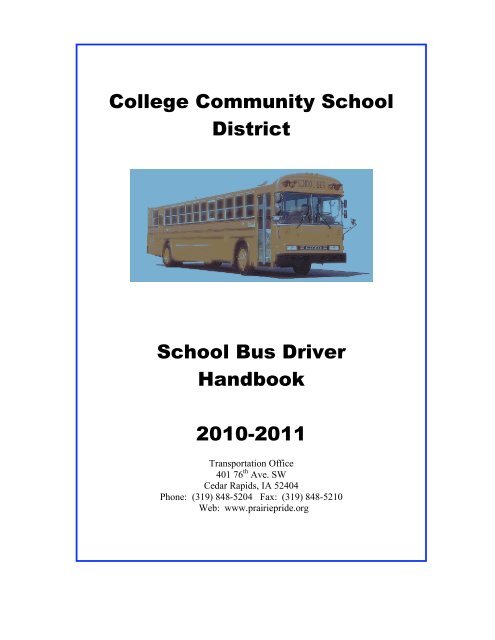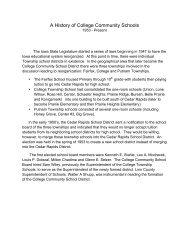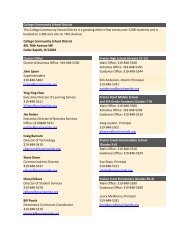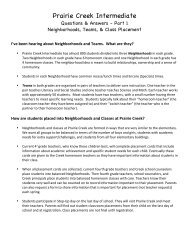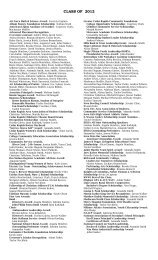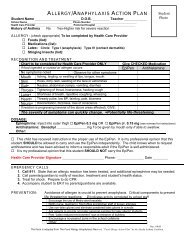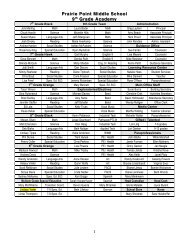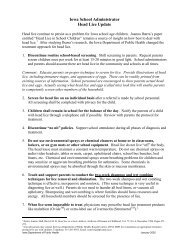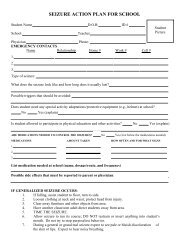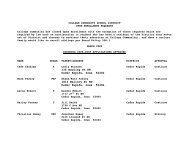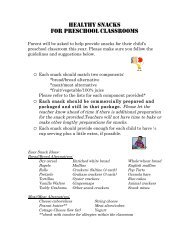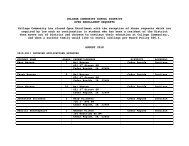College Community School District School Bus Driver Handbook ...
College Community School District School Bus Driver Handbook ...
College Community School District School Bus Driver Handbook ...
You also want an ePaper? Increase the reach of your titles
YUMPU automatically turns print PDFs into web optimized ePapers that Google loves.
<strong>College</strong> <strong>Community</strong> <strong>School</strong><br />
<strong>District</strong><br />
<strong>School</strong> <strong>Bus</strong> <strong>Driver</strong><br />
<strong>Handbook</strong><br />
2010-2011<br />
Transportation Office<br />
401 76 th Ave. SW<br />
Cedar Rapids, IA 52404<br />
Phone: (319) 848-5204 Fax: (319) 848-5210<br />
Web: www.prairiepride.org
Index for the <strong>School</strong> <strong>Bus</strong><br />
<strong>Driver</strong> <strong>Handbook</strong><br />
Guiding Principals 4<br />
Organizational Chart 5<br />
Personnel and Phone Numbers 6<br />
Building Codes 6<br />
Accidents and Emergencies 7-9<br />
Fire Extinguisher Use 10<br />
<strong>Bus</strong> Is Stuck / What to Do 10-11<br />
Allocation of <strong>Bus</strong>es 11<br />
Authorized Passengers 12<br />
Behavior, Bullying and <strong>Bus</strong> Rules 12-15<br />
Job Descriptions 16-19<br />
<strong>Bus</strong> Routes 20<br />
Carry On Items 20-21<br />
Cell Phones 21<br />
Check-In Procedures 21-22<br />
Children on Property 22<br />
Clean <strong>Bus</strong>es 23<br />
Confidentiality 23<br />
<strong>Driver</strong>s Notifying the <strong>District</strong> 24<br />
Eating on the <strong>Bus</strong> 24<br />
Lost and Found 25<br />
2
<strong>Driver</strong>’s Mailboxes 25<br />
Maintenance and Inspections 25-26<br />
Occupational Health and Safety 26-28<br />
Parking <strong>Bus</strong>es 28<br />
Payroll, FMLA Notice and Personnel Files 29-32<br />
Personal Use of Equipment 32<br />
Professionalism and Public Image 33-34<br />
Resignation Forms 34<br />
<strong>Bus</strong> Danger Zones 34-36<br />
Sick Call-In 36<br />
Smoking 37<br />
Special Trips 37-38<br />
Severe Weather Cancellations and Delays 38<br />
Student Accidents 38-39<br />
Tickets/Stop Arm Violations 39<br />
Radio Protocol 39-40<br />
Worker’s Compensation 40-41<br />
Forms 41<br />
3
<strong>College</strong> <strong>Community</strong> <strong>School</strong><br />
<strong>District</strong><br />
<strong>Bus</strong> <strong>Driver</strong>/Aide<br />
Guiding Principles<br />
As a school bus driver, you have an extremely important job and responsibility. From the time<br />
your bus makes the first stop on your route until the last passenger disembarks, the safety of<br />
someone else's children is in your hands.<br />
Our goal in the <strong>College</strong> <strong>Community</strong> <strong>School</strong> <strong>District</strong> is to continually improve the safety and<br />
efficiency of our school transportation program. The safety of the children who ride school buses<br />
depends greatly on the dedicated men and women who accept the important responsibility of<br />
driving our school buses.<br />
We feel we have the responsibility to provide school bus drivers with information that will help<br />
you develop proper skills, attitudes and knowledge that will result in safe and efficient driving<br />
procedures. We believe this handbook contains that necessary information.<br />
Remember that everything involved in the operation of a school bus is focused on one single idea -<br />
- PASSENGER SAFETY COMES FIRST! We hope that you have a very safe and enjoyable<br />
school year.<br />
4
Organizational Chart<br />
For the Transportation<br />
Department<br />
Executive Director<br />
of <strong>Bus</strong>iness Services<br />
– James Rotter<br />
Director of<br />
Transportation –<br />
Scott Grabe<br />
Head <strong>Bus</strong> Mechanic<br />
– Mark Hurt<br />
Administrative<br />
Assistants – Sharon<br />
Meskimen and Kris<br />
Hartgrave<br />
Shop Mechanic,<br />
Service Person &<br />
Gasser<br />
<strong>Bus</strong> <strong>Driver</strong>s &<br />
Aides<br />
5
CCSD Transportation<br />
Department<br />
Personnel and Numbers<br />
CCSD Transportation Department Personnel:<br />
Superintendent of <strong>School</strong>s: Mr. Richard Whitehead 848-5201(work)<br />
Executive Director of <strong>Bus</strong>iness Services: Mr. James Rotter 848-5221(work)<br />
Director of Transportation: Scott Grabe 848-5205(work)<br />
857-4445(home)<br />
540-5205(cell)<br />
Head Mechanic: Mark Hurt 848-5206(shop)<br />
377-5461(home)<br />
Administrative Assistants: Sharon Meskimen 848-5204(work)<br />
857-5027(home)<br />
Kris Hartgrave<br />
848-5204(work)<br />
396-3262(home)<br />
Shop Mechanic: Larry Zach 848-5206(shop)<br />
848-4380(home)<br />
AM Sick Call-in Number (before 5:45am):<br />
848-5206(shop)<br />
Building Code Numbers<br />
Prairie High (10 th -12 th grade) 109<br />
Prairie Point (7 th -9 th grade) 227<br />
Prairie Creek (5 th -6 th grade) 409<br />
Prairie Crest (K-4 th grade) 418<br />
Prairie Heights (K-4 th grade) 427<br />
Prairie Ridge (K-4 th grade) 421<br />
Prairie View (K-4 th grade) 431<br />
6
Accidents & Emergencies<br />
Accidents:<br />
All vehicular accidents causing ANY damage and/or injury must be reported immediately to the<br />
Director of Transportation. Failure to do so may be cause for immediate termination. If you are<br />
involved in an accident, radio the office first and advise us of...<br />
1. Location?<br />
2. Injuries?<br />
3. If police have been notified?<br />
4. Should another bus be dispatched?<br />
5. Any other problems you are experiencing.<br />
You are required to stay at the accident scene until released by either law enforcement or school<br />
district administrators. At the accident scene the safety of the students is your primary<br />
responsibility. Refrain from discussing the accident with anyone other than law enforcement or<br />
school administrators. The accident scene is not the place to determine who is “at fault”. After<br />
ALL students safety is secured, begin collecting information about the incident including names,<br />
addresses, telephone numbers, vehicle information and witness information. When you are<br />
released from the accident scene you are required to report to the Director of Transportation for<br />
follow up reporting and required drug/alcohol testing.<br />
<strong>School</strong> <strong>Bus</strong> Emergency Plan:<br />
<strong>School</strong> bus emergencies can happen anywhere, anytime or involve anyone. Time of day, day of<br />
week, weather conditions, road surface conditions, construction, other vehicles or our own<br />
passengers can all be contributing factors. What to do in case of an emergency? The following is<br />
a set of practical guidelines for a school bus emergency.<br />
These skills are practices twice each school year as mandated by Iowa Code. It is the driver’s<br />
responsibility to assure this is done and that the appropriate documentation verifying the drill is<br />
completed and has been turned in.<br />
Assessing the Need to Evacuate:<br />
Student safety and control is best maintained by keeping students on the bus during an emergency<br />
and/or impending crisis situation if doing so does not expose them to unnecessary risk or injury. A<br />
decision to evacuate should include consideration of the following conditions:<br />
1. Recognize the hazard. The decision to exit/evacuate the bus must be a timely one.<br />
2. Is there a fire involved?<br />
3. Is there a smell of raw or leaking fuel?<br />
4. Is the bus likely to be hit by other vehicles?<br />
7
a. The person in charge will direct the unloading through the front door, roof hatches,<br />
and/or windows. When unloading through the emergency door or through the<br />
windows a student helper should be on the ground to assist the students.<br />
5. Does the possibility exist that the bus will roll/tip causing further threat to safety?<br />
6. Is the bus in direct path of a sighted tornado?<br />
7. Has there been a major incident creating a dangerous environment?<br />
8. Would removing students expose them to speeding traffic, severe weather or a dangerous<br />
environment such as downed power lines?<br />
9. Would moving pupils complicate injuries such as neck, back and other fractures?<br />
10. Is there a hazardous material spill involved? It may be safer to remain on the bus and not<br />
come in contact with the material.<br />
General Procedures for Emergency Evacuation:<br />
Keep the situation as orderly and efficient as possible. If time and conditions permit, the bus<br />
driver should use the radio to advise our office of the following:<br />
• The exact location, including the nearest intersecting road or familiar landmark.<br />
• The condition creating the emergency.<br />
• The type of assistance needed, (police, fire, ambulance).<br />
• Notification that the bus is being evacuated.<br />
Analyze conditions to determine the safest exits from the bus. During the evacuation, monitor<br />
conditions and adjust procedures to meet unexpected circumstances. The driver may have to<br />
conduct the evacuation from outside the bus.<br />
Move evacuated students to the nearest safe location at least 100 feet from the bus. The<br />
regrouping area must be upwind of any airborne hazards.<br />
After the decision to evacuate is made, take the first aid kit with you. Put the microphone of the<br />
radio out the drivers left window if it is still operable. This will allow you to transmit additional<br />
information to our office.<br />
Be prepared to give information to emergency medical personnel regarding individual student’s<br />
medical or physical requirements.<br />
In an Emergency:<br />
1. In case of an accident, the driver or the student assistant will direct all children to unload<br />
through an emergency exit. The nature of the accident will determine the doors or hatches<br />
to be used. The emergency exits are only to be used in case of an emergency.<br />
2. Try to keep the students calm. They should follow all instructions given by the driver or<br />
student assistant.<br />
3. When the rear emergency door is used to unload:<br />
a. The students at the rear of the bus should unload first working the way to the front<br />
of the bus<br />
b. Remove the ignition key<br />
c. If the driver or student assistant cannot get to the emergency door, then the student<br />
nearest the door should open it.<br />
4. After all students have unloaded from the school bus:<br />
a. Keep them in a group at least 100 feet away from the bus<br />
b. Keep them from wandering around<br />
8
5. In case the driver is unable to get out of the bus:<br />
a. The student assistant should radio for help<br />
b. If need be, go to a nearby house to get help<br />
6. If after the accident, the school bus is in such a position that the rear emergency door will<br />
not open:<br />
a. Keep students clear of the bus (100 feet minimum)<br />
b. Keep students off the roadway<br />
c. Aid all students that are hurt and scared<br />
Student Assistants:<br />
In case the driver becomes incapacitated each bus should have at least three (3) students that know<br />
what to do in an emergency. Students appointed to assist the drivers should possess the following<br />
qualifications:<br />
1. Maturity<br />
2. Good Citizenship<br />
3. Leadership Ability<br />
Appointed student assistants should be trained to do the following:<br />
1. Turn off ignition switch and shut down the engine.<br />
2. Set the emergency brakes.<br />
3. Summon help when and where needed; know how to use the radio.<br />
4. Use the emergency windows or escape exits.<br />
5. Open and close doors<br />
6. Account for all students<br />
7. Help small students off the bus<br />
8. Set out warning reflectors<br />
9. Perform other duties as assigned<br />
9
Operating ABC Fire Extinguishers:<br />
1. Remove the extinguisher from the clamp bracket.<br />
2. Grasp unit and pull lock pin from lever and handle. Hold unit upright with hand<br />
under handle and thumb on top of lever. Unit will discharge the dry chemical agent<br />
ONLY IN UPRIGHT POSITION.<br />
3. Keep safe distance from fire (at least 6 feet) and near an exit. Aim nozzle at<br />
base of fire (not at flames or smoke). Do not get too close as the discharge stream<br />
may scatter the fire. If it does, move back. Play it safe. Keep away from the fire's<br />
fuel source and avoid breathing vapors, fumes and heated smoke as much as<br />
possible.<br />
4. Press lever downward and spray dry chemical powder (powder stream will<br />
shoot over a 6 foot distance) at base of flames in quick, side-to-side motion to erase<br />
the flames. When the extinguishing agent comes in contact with the fire, the fire<br />
will flare and appear to grow larger. This is a temporary reaction before the agent<br />
suppresses the fire. Direct the entire discharging dry chemical agent on the fire.<br />
Procedure to follow if stranded in a storm:<br />
The threat of a severe winter storm is always a concern of school bus drivers in Iowa. If you<br />
become stranded in a winter storm, knowing some procedures to follow could eliminate some of<br />
your worry. The following procedures are listed for your benefit, but remember that using<br />
common sense is your best asset when problems arise.<br />
1. Do Not Panic: Work slowly, avoid overexertion. Attempting to push a vehicle or shovel<br />
heavy drifts of snow may lead to a heart attack. Before making any decision, be sure you<br />
are in control of your emotions, using common sense.<br />
2. Stay in Your Vehicle: Never leave your bus unsupervised. Do not send anyone for help<br />
by walking unless you can observe that person all the way to a nearby home. Your bus<br />
10
provides the best protection from the weather and it is easier for school personnel, road<br />
maintenance crews or law enforcement officers to locate you if you remain in your bus.<br />
3. Keep Fresh Air Circulating: Carbon monoxide can build up if a vehicle is sealed by<br />
blowing and drifting snow. Run the motor and heater sparingly and open only the<br />
downwind windows for ventilation.<br />
4. Keep Active: The driver must be the leader in periodically doing such things as clapping<br />
hands and moving arms and legs vigorously to stimulate circulation, relieve tension and<br />
help keep awake.<br />
5. Turn on Your Vehicle's Dome Lights: The light will help you observe others and make<br />
the vehicle more visible to anyone traveling the same roadway.<br />
6. Try to conserve fuel and electrical supply (battery).<br />
Bad Road/<strong>Bus</strong> is Stuck:<br />
In case of bad roads, if you become stuck, call the transportation office by radio and a bus will be<br />
sent out to assist you. A mechanic will also be sent out to help you. Do not allow a passersby to<br />
attempt to pull you out. Advise them that help is on the way or have them telephone the office.<br />
Do not repeatedly try to drive the bus out yourself, as this could do severe damage. There are sand<br />
bags in the back of the bus to help in icy conditions. Please assure that these bags do not block<br />
emergency exits or the aisle during your pre-trip inspections.<br />
Allocation of <strong>Bus</strong>es<br />
Allocation of <strong>Bus</strong>es:<br />
New buses will be assigned to routes at the sole discretion of the district. The Transportation<br />
Director will consider many criteria for those assignments. One criterion that will be used that is<br />
controlled by the driver is how well a bus is maintained and treated. Those drivers that do not<br />
properly clean their buses, allow students or staff to mistreat the buses or mistreat the buses<br />
themselves will be assigned to older buses.<br />
All in-town extra-curricular trips will be REQUIRED to take a “sub” bus when the trip<br />
encompasses a regular route time. If you are not assigned a particular sub bus, please check with<br />
the Head Mechanic for that assignment. For bus assignment purposes, Johnson and Linn County<br />
trips are considered in-town. It is much preferred that we use the bus assigned to a particular route<br />
on the route instead of on extra-curricular trips.<br />
11
Authorized Passengers<br />
Authorized Passengers:<br />
Only students assigned to your bus are allowed to ride your bus unless they present proper<br />
authorization issued either by the transportation office or a school building. Since there is no way<br />
to verify the authenticity of a handwritten note “from home”, no driver should accept these as<br />
permission to get on your bus. If you are in doubt about any note you receive, PLEASE ASK.<br />
With prior permission, you may allow your school age children or grandchildren to ride with you<br />
on your route if space is available. They must follow and abide by the same rules as you expect<br />
from your other students. No others, related or not, are allowed to ride with you on your<br />
route.<br />
At no time are any persons allowed onto your bus unless you recognize them as school staff or<br />
emergency response personnel. It is especially important that we not allow adults onto the bus.<br />
You have no way of knowing what their intent is and it is your responsibility to protect the<br />
students on the bus. If someone tries to board your bus, be courteous to them. Ask them to speak<br />
with you at the driver’s window if traffic permits, or to speak with you at the bottom of the steps.<br />
Under no circumstances should you allow them to board the bus at any time!<br />
Behavior Issues & Bullying<br />
Behavior Issues & Bullying:<br />
We must ensure that children are not harassed and bullied in our schools, school yards and school<br />
buses. If it is happening on your bus, please make sure it is addressed. We must work on this<br />
together.<br />
Driving a bus in today's traffic is a major responsibility, which makes it necessary for all students<br />
to conduct themselves in the best possible manner.<br />
You are in charge of your bus! Students need guidelines or clear expectations of proper behavior<br />
on the bus. Appropriate student conduct contributes to safety. It helps avoid accidents, which may<br />
result from the distraction of the bus driver. It also reduces the number of accidents in which<br />
students injure themselves or each other.<br />
12
All drivers need to follow these guidelines in controlling the behavior of the students on your bus.<br />
A copy of the bus rules and regulations for students riding our buses were given to the parents.<br />
Please make sure you and your riders are familiar with the rules.<br />
1. Assign seats -- You can keep them in the same seat all year, rotate the seats by each<br />
quarter, have open seating days or assign seats to only those students you feel it necessary.<br />
Assigning seats will help you learn the passengers name quicker and will stop the fighting<br />
over a seat. This will also help a substitute driver in keeping better control when they are<br />
driving your route.<br />
2. Make sure everyone on your route knows the school bus riding rules. Make them follow<br />
the rules everyday -- be consistent!!<br />
3. Be friendly, say good morning, and call the students by name. In the afternoon say goodbye.<br />
Be a good model for being friendly!<br />
4. Be firm, fair and consistent. Be firm. Don't bend the rules. Be fair in handling problems<br />
on your bus. Listen to both sides and then stop the problem. Stay consistent with your<br />
rules. Don't write a "trouble maker" up for throwing paper on the bus and let a "good kid"<br />
throw paper without writing them up. If a rule is broken, document and report.<br />
5. Be alert. Know your students. Know how they behave. Know what is going on. Try to<br />
stop minor problems before they are major problems. One of the largest mistakes you can<br />
make is doing nothing about inappropriate behavior.<br />
6. Keep your cool. Don't overreact and make a bigger problem. Stay in control of your<br />
emotions and handle the situation.<br />
7. Keep a positive attitude. Don’t let the little things pile up and affect your attitude.<br />
8. Please remember: You Don’t Need to Win Today!<br />
9. Be assertive -- You're in charge. Riding a school bus is a privilege, not a right! Students<br />
need to abide by our rules to ride our buses.<br />
10. At the bus loading zone after school, be on your bus and expect good behavior from the<br />
time the students walk on the bus. If you wait until everyone is on the bus and you start<br />
moving, it may be too late.<br />
11. Don't hold a grudge. The student broke a rule; you reported it, so move on. Don't look for<br />
trouble the next day.<br />
12. NEVER use profanity when dealing with students. Doing so is cause for immediate<br />
dismissal.<br />
13. Be able to identify rules and offenders and know all of the facts.<br />
13
14. If you are having a problem, pull over to a safe area, contact our office that you are pulled<br />
over, and try to calm down the students. If they do not settle down, call our office and we<br />
will advise.<br />
15. Students are only to be dropped off at their designated spot. Under no circumstances do<br />
you “put a student off the bus” for misbehavior. You do not have the authority to suspend<br />
students from your bus. Report the incident, have all of the information and then it is up to<br />
the Director to deal with the consequences.<br />
16. Don't be a "one more time" person. Don't keep saying, "If you do that one more time, I am<br />
going to write you up". If they break a rule, handle it and move on.<br />
17. All drivers are STRONGLY encouraged to communicate with the parents when you notice<br />
inappropriate behavior. Often times having that rapport with the parents can work well in<br />
quelling future misbehavior. When you find it necessary to report a student’s conduct to<br />
the Director of Transportation, please fill out the conduct report form in as much detail as<br />
possible. When you are finished filling out the form, hold on to it until you can meet<br />
with the Director personally. This gives the Director the opportunity to ask questions<br />
about the incident so that they will have an understanding of the incident prior to speaking<br />
with the student. It is the director’s responsibility to ensure that the student receives the<br />
proper consequences for a given violation. This will be decided on a case-by-case basis,<br />
taking into consideration a number of variables. The discipline could range from a verbal<br />
warning to a 1 calendar year suspension from the bus. You should expect a reply from the<br />
director as to what action was taken in a timely fashion.<br />
14
SCHOOL BUS RULES<br />
• BE ON TIME. Keep the bus on schedule<br />
• OBEY THE DRIVER’S INSTRUCTIONS.<br />
• Keep your entire body INSIDE THE BUS.<br />
• For your safety, REMAIN SEATED AT ALL TIMES.<br />
• Be courteous!! (NO BAD LANGUAGE)<br />
• Work together to KEEP YOUR BUS CLEAN AND<br />
SAFE<br />
• HAZARDOUS OBJECTS are not allowed on the bus<br />
• Keep the noise level down, NO RADIOS OR TAPE<br />
PLAYERS<br />
• Absolutely NO eating or drinking (water is acceptable)<br />
• If you must cross the street after unloading, WALK 10<br />
FEET IN FRONT OF THE BUS and WAIT FOR<br />
DIRECTIONS FROM THR DRIVER.<br />
15
<strong>Bus</strong> <strong>Driver</strong>/<strong>Bus</strong> Aide Job<br />
Descriptions and<br />
requirements for<br />
certification<br />
Position Title:<br />
Reports To:<br />
<strong>School</strong> <strong>Bus</strong>/Van <strong>Driver</strong><br />
Director of Transportation<br />
Preparation, Experience, Skills:<br />
• Maintain a valid Iowa <strong>Driver</strong>s License appropriate for the vehicle assigned including<br />
required endorsements and restriction removals.<br />
• Maintain an Iowa Department of Education <strong>School</strong> <strong>Bus</strong> <strong>Driver</strong>’s Permit.<br />
• Maintain a driving record satisfactory to the <strong>District</strong> and the <strong>District</strong>’s insurance carrier.<br />
• Ability to recognize and perform job tasks with a minimum of supervision.<br />
• Adhere to all federal, state and local rules and regulations pertaining to the safe operation<br />
of a school bus.<br />
• Complete all paperwork and tasks as required.<br />
• Attend all in-service meetings and classes of instruction as required by the Department of<br />
Education and the <strong>College</strong> <strong>Community</strong> <strong>School</strong> <strong>District</strong>.<br />
Principle Duties:<br />
• Under the supervision of the Director of Transportation, insure that each student assigned<br />
to ride a bus during regular routes and/ or extra curricular trips is afforded a safe and<br />
comfortable ride.<br />
• Clean assigned vehicle for the purpose of maintaining appearance, sanitation and safety of<br />
the vehicle.<br />
• Conduct pre and post trip inspections, appropriately documenting and reporting all<br />
deficiencies.<br />
• Direct the students regarding appropriate conduct for the purpose of enforcing rules,<br />
regulations, laws and safety.<br />
• Maintain regular and appropriate attendance and be on time for assignment(s) for the<br />
purpose of meeting the needs of the students and the district.<br />
• Other duties as may be assigned<br />
Physical requirements/Working conditions:<br />
• Ability to complete all required tasks independently.<br />
• Ability to stand/walk for extended periods of time as necessary.<br />
• Ability to drive for an extended period of time.<br />
• Ability to use hands for repetitive pushing, pulling, grasping and fine manipulation.<br />
• Ability to use feet for repetitive motion consistent with operating assigned vehicles.<br />
• Ability to bend, squat and climb stairs frequently.<br />
• Sufficient strength and agility to assist riders with ingress and egress during normal<br />
transportation and in emergency situations.<br />
• Sufficient strength and agility to assure student is placed in and is utilizing appropriate<br />
restraint devices.<br />
• Sufficient strength and agility to protect students from harm by themselves or others.<br />
16
• Ability to withstand inclement weather conditions.<br />
• Ability to withstand moderate noise levels from vehicles and students.<br />
• Ability to maintain intense concentration while performing multiple tasks and avoid<br />
excessive mental or emotional fatigue.<br />
Terms of<br />
Employment: The regular school year (180 days) plus any extra trips that may<br />
be assigned per the terms of the Meet and Confer Agreement.<br />
Date of<br />
Revision: 3/15/08<br />
Requirements for Certification:<br />
<strong>School</strong> <strong>Bus</strong> Authorization:<br />
Certification for school bus drivers is a State Department of Education requirement. <strong>Driver</strong>s must<br />
complete and submit the following to the transportation office prior to being allowed to drive:<br />
Physical:<br />
A standard D.O.T. physical is required. All aspects of the physical need to be addressed on the<br />
approved physical form prior to submittal. The health professional giving the physical will issue<br />
the appropriate “Examiners Medical Certificate” which must be carried with the driver at all times.<br />
Acceptable Driving Record:<br />
Iowa Administrative Code forbids the school district from allowing anyone to transport students<br />
without an “acceptable driving record”. The decision of what an acceptable driving record is will<br />
be determined on a case-by-case basis. Several factors will be taken into consideration in making<br />
this determination including type/severity of violations, disposition, accident record, number of<br />
violations, age of violations, etc.<br />
The <strong>District</strong> may, at any time, send for all past moving violations and accident involvement. This<br />
information will be verified through the State of Iowa <strong>Driver</strong>'s License Division. Falsification of<br />
information or failure to report any violations/accidents may result in the applicant/employee not<br />
being employed and/or terminated.<br />
<strong>Driver</strong> Training:<br />
Each driver is required to complete a 12-hour basic course of instruction within a 6 month time<br />
period. This time period commences from the date of your initial authorization. Until that is<br />
completed, a driver is issued a temporary authorization. Each driver is also required to complete a<br />
3-hour course of instruction each and every year.<br />
Drug Testing:<br />
All drivers are required to submit to district drug and alcohol testing. The district contracts this<br />
service through a third party provider. Drug testing will be conducted in strict compliance with<br />
DOT and State of Iowa guidelines.<br />
17
Position Title:<br />
Reports To:<br />
<strong>School</strong> <strong>Bus</strong> Aide<br />
Director of Transportation<br />
Preparation, Experience, Skills:<br />
• Ability to recognize and perform job tasks with a minimum of supervision.<br />
• Adhere to all applicable federal, state and local rules and regulations pertaining to school<br />
bus transportation.<br />
• Complete all paperwork and tasks as required.<br />
• Attend all in-service meetings and classes of instruction as required by the <strong>College</strong><br />
<strong>Community</strong> <strong>School</strong> <strong>District</strong>.<br />
Principle Duties:<br />
• Under the supervision of the Director of Transportation, insure that each student assigned<br />
to ride a bus during regular routes and/ or extra curricular trips is afforded a safe and<br />
comfortable ride.<br />
• Clean assigned vehicle for the purpose of maintaining appearance, sanitation and safety of<br />
the vehicle.<br />
• Direct the students regarding appropriate conduct for the purpose of enforcing rules,<br />
regulations, laws and safety.<br />
• Maintain regular and appropriate attendance and be on time for assignment(s) for the<br />
purpose of meeting the needs of the students and the district.<br />
• Other duties as may be assigned<br />
Physical requirements/Working conditions:<br />
• Ability to complete all required tasks independently.<br />
• Ability to stand/walk for extended periods of time as necessary.<br />
• Ability to use hands for repetitive pushing, pulling, grasping and fine manipulation.<br />
• Ability to bend, squat and climb stairs frequently.<br />
• Sufficient strength and agility to assist riders with ingress and egress during normal<br />
transportation and in emergency situations.<br />
• Sufficient strength and agility to assure student is placed in and is utilizing appropriate<br />
restraint devices.<br />
• Sufficient strength and agility to protect students from harm by themselves or others.<br />
• Ability to withstand inclement weather conditions.<br />
• Ability to withstand moderate noise levels from vehicles and students.<br />
• Ability to maintain intense concentration while performing multiple tasks and avoid<br />
excessive mental or emotional fatigue.<br />
Terms of Employment:<br />
The regular school year (180 days) plus any extra trips that may<br />
be assigned per the terms of the Teamster’s contract.<br />
Salary Grade: Salary grade 1<br />
Date of<br />
Revision: 6/3/09<br />
19
<strong>Bus</strong> Routes<br />
<strong>Bus</strong> Routes:<br />
<strong>Driver</strong>s are required to carry their route books with them at all times on the bus during their route.<br />
No exceptions. <strong>Driver</strong>s must return the route book to its respective slot after every route. It is<br />
expected that the route book will be updated at all times. The information that needs updating is;<br />
Student drops or adds, time of each stop, location of stop, student names, student grade and student<br />
building. Stop and Turn sheets that are a part of the route book are expected to be updated<br />
at all times as well.<br />
<strong>Driver</strong>s are not permitted to change their route unless authorization is received from the Director of<br />
Transportation prior to making the changes. This also includes adding stops that are not<br />
designated in your route book. State Code dictates that all stops be reviewed and approved by<br />
the Director of Transportation. If you add a stop that is not approved and you do this without the<br />
Director’s knowledge, you are assuming responsibility that is not yours to assume. This could lead<br />
to increased liability for you.<br />
It is imperative that drivers watch there times during the route to ensure they are running the route<br />
as expected. In the beginning of each school year all parents are informed what the stop location<br />
and stop times are. Running a route contrary to those times causes frustration and angry phone<br />
calls. RUN THE ROUTE EXACTLY AS IT STATES IN THE ROUTE BOOK AT ALL TIMES!<br />
Failure to follow these directives may result in the loss of your assigned route or termination.<br />
Carry On Items<br />
Carry On Items:<br />
<strong>Driver</strong>s shall try to accommodate students if they wish to bring school projects, sports equipment,<br />
band instruments or other items on the bus.<br />
<strong>Driver</strong>s should ask students to talk to them in advance if they wish to do this.<br />
The driver must specify a location for the item. The item should be retained with the student in<br />
their seat as long as the item does not pose a safety risk. <strong>Driver</strong>s have the option to place the item<br />
in the front of the bus if they so choose.<br />
20
Students, who have long dangerous items poking out of their backpacks, will have to remove the<br />
item and store it at the front or where the driver designates. <strong>Driver</strong>s may move students to a front<br />
seat to look after an item that requires looking after.<br />
Drugs, tobacco, alcohol, fire arms, ammunition, live animals, skateboards, bicycles, or any other<br />
item the driver deems unsafe or inappropriate to transport are not allowed on the school bus.<br />
Cell Phones<br />
Cell Phones:<br />
<strong>Driver</strong>s are NEVER allowed to use cell phones at any time while driving a school owned vehicle<br />
whether there are students on the bus or not. A violation of this policy may result in immediate<br />
dismissal. <strong>Driver</strong>s are also not allowed to use their cell phones or any other electronic device that<br />
may cause a distraction, driving or not, when students are present on the bus. Your attention needs<br />
to be focused on the students that are in your care. This does not apply in a true emergency. If<br />
there is an emergency that requires cell phone usage it is absolutely mandatory that the driver pull<br />
off to the side of the road and park before using the cell phone.<br />
Check-In Procedure<br />
Check-In Procedure:<br />
Please remember to cross your name off the morning and afternoon lists. The sheet is posted<br />
under the punch-in clock. This is the only way we know that you are here and ready to drive<br />
your route. IMMEDIATELY after check-in, pre-trip your bus. This gives the mechanics some<br />
time to fix found issues if they can. If not, you will be assigned a sub bus.<br />
Morning Drop-Off Procedure:<br />
The following locations and times will be used for dropping off students in the morning;<br />
Early Routes-<br />
21
Prairie Creek: By the Basketball Courts using the road around the football field. No earlier than<br />
7:35am.<br />
Prairie Point: In the back of the building. Enter the North drive. No earlier than 7:35am.<br />
Late Routes-<br />
High <strong>School</strong>: In the Loading Zone between the double light pole and the electric boxes. No<br />
earlier than 8:35am<br />
Prairie Ridge: At the front door. ONLY enter Ridge via the road next to the bus bull-pen. No<br />
earlier than 8:35am.<br />
Prairie Crest/View: At the southwest corner of Crest. No earlier than 8:35am.<br />
Prairie Heights: At the west side of the building. No earlier than 8:35am.<br />
Afternoon Loading Procedure:<br />
Early Routes-<br />
Shuttle buses that take students from Creek to the loading zone need to be in their designated<br />
shuttle spot at Creek no later than 2:40pm. These shuttle buses will stage in the basketball court<br />
area and the area behind Creek. The shuttle bus is assigned to a specific route as an extension of<br />
that route and not a separate route in itself. Please keep that in mind when bidding routes. If a<br />
driver bids a shuttle route and does not want or is not able to continue it they may be required to<br />
give up the entire route. All other buses will stage in the parking lot and perimeter road behind<br />
Point. Spaces are numbered by route. Please pull into your assigned space NO LATER THAN<br />
2:40. Remember, state law dictates that a driver be on their bus at all times when students are on<br />
the bus, whether the bus is running or not.<br />
Late Routes-<br />
All students will be loaded in the bus loading area between the High <strong>School</strong> and Prairie Crest.<br />
Spaces are numbered by route. Please pull into your assigned space NO LATER THAN 3:45.<br />
Remember, state law dictates that a driver be on their bus at all times when students are on the bus,<br />
whether the bus is running or not. In the event of adverse weather, you may be asked to pick up<br />
students at their respective buildings.<br />
Shuttle buses that take students from Heights to the loading zone need to be in their designated<br />
shuttle spot at Heights no later than 3:35pm. The shuttle bus is assigned to a specific route as<br />
an extension of that route and not a separate route in itself. Please keep that in mind when bidding<br />
routes. If a driver bids a shuttle route and does not want or is not able to continue it they may be<br />
required to give up the entire route.<br />
22
Children in <strong>Driver</strong>s Room<br />
and On Property<br />
Children in <strong>Driver</strong>s Room and On Property:<br />
Children and Grandchildren of drivers are allowed in the driver’s room only. Remember, you are<br />
the responsible adult and must provide supervision. Children are not allowed in the garage area at<br />
any time nor are they allowed in the parking lots unsupervised.<br />
Clean <strong>Bus</strong>es<br />
Clean <strong>Bus</strong>es:<br />
It is the expectation of the school district that buses are clean inside and out. All buses have<br />
brooms and spray bottles in them for this purpose. Please do not remove them from the bus.<br />
<strong>Bus</strong>es should be cleaned prior to each route and after each special trip. Plenty of time is allotted<br />
each day for this purpose.<br />
Confidentiality<br />
Confidentiality -<br />
<strong>Bus</strong> drivers shall not make comments, or otherwise share information, about students, except to<br />
school personnel that have a need to know the information. Please refrain from idle gossip about<br />
students or staff to anyone including other drivers, other staff, parents, the public or students.<br />
<strong>Bus</strong> drivers shall keep all information regarding staff, students, parents or school district business<br />
absolutely confidential. A violation of confidentiality may lead to dismissal.<br />
23
<strong>Driver</strong>s Need to Notify<br />
<strong>School</strong> <strong>District</strong> in the<br />
following circumstances:<br />
<strong>Driver</strong>s Need to Notify <strong>School</strong> <strong>District</strong> in the following circumstances:<br />
<strong>Driver</strong>s need to notify the Director of Transportation in the following circumstances:<br />
- If your license status is denied, suspended, revoked or barred;<br />
- If you receive a citation for ANY traffic violation or are involved in ANY traffic<br />
collision whether you receive a citation or not. This applies to all circumstances<br />
whether you are driving a school bus or any other vehicle both on and off duty;<br />
- If you receive information that you have a medical condition which could be<br />
detrimental to safe bus operation, this includes prescriptions for medication;<br />
- If you get stuck, hit the ditch, require a tow truck, have an accident or have a near<br />
accident while driving a school bus;<br />
When you renew your license you need to give a copy to Transportation office. If you<br />
would like reimbursement for a portion of your license you must also provide a receipt for<br />
the renewal.<br />
Eating on the <strong>Bus</strong><br />
Eating on the <strong>Bus</strong>:<br />
We have a great number of students with some very severe food allergies, therefore no eating or<br />
drinking is allowed on any bus. We do allow students to bring water on the bus. As you can<br />
imagine, this is a very hard issue to enforce. Students are very adept at “sneaking” food and<br />
snacks onto the bus. Please do your best to enforce this policy. This policy does not apply to<br />
special trips.<br />
24
Lost and Found<br />
Lost and Found:<br />
If a student leaves something on the bus, check for their name, and leave it on the bus for two days<br />
for pick up. Try and return the item during the next route. If not claimed, turn in to the<br />
transportation office. Do not place items on the dash of your bus. If the item is of value or it is an<br />
item you feel the student needs that day, please bring it into the office.<br />
<strong>Driver</strong>’s Mailboxes<br />
Mail Boxes:<br />
All drivers have been assigned a mailbox in the driver’s room. Check your mailbox daily before<br />
and after your routes for messages or other important information. Please do not leave anything in<br />
it like coffee cups, etc.<br />
Maintenance, Inspections<br />
and Oil Changes<br />
Maintenance and Inspections:<br />
The Transportation Director and Head Mechanic are responsible for implementing an ongoing<br />
preventative maintenance program and for ensuring that school buses meet the requirements of the<br />
State of Iowa as outlined in Iowa Code.<br />
<strong>Driver</strong> Responsibilities:<br />
Pre-trip Vehicle Inspection:<br />
25
According to Rule 22.41 of the Iowa Administrative Code "A daily pre-trip inspection of each<br />
school bus shall be performed and recorded." Ample paid time is allotted to complete this<br />
requirement. It is the driver’s responsibility to “pre-trip inspect” their vehicle prior to leaving the<br />
bus lot. This must be performed before each driving assignment. If a vehicle has a deficiency,<br />
contact a mechanic prior to leaving for your route. Let the mechanic determine if the bus is fit for<br />
service. You are also required to perform a “post-trip inspection” after each route. At the end of<br />
each week you are required to turn the pre-trip sheet into the office by placing it into the box by<br />
the time-clock.<br />
Mechanics Slips:<br />
During your pre-trip inspection if you note a mechanical problem, contact a mechanic prior to<br />
leaving on your route to see if the problem should be corrected immediately. During your route, if<br />
you feel there is a mechanical problem that needs immediate attention contact the garage staff by<br />
radio. If you feel it can wait until you get back from your route, fill out a repair slip and give it to<br />
one of the mechanics when you return.<br />
Occupational Health &<br />
Safety<br />
Safety in the Workplace:<br />
The personal safety and health of each employee of the <strong>College</strong> <strong>Community</strong> <strong>School</strong> <strong>District</strong> is of<br />
primary importance. To the greatest extent possible, the <strong>District</strong> is committed to providing the<br />
safest work environment possible for all employees regardless of job duties. It is the philosophy of<br />
the <strong>District</strong> that all employees shall cooperate in all areas of safety while performing the functions<br />
of their position. Only through such cooperation can the <strong>District</strong> effectively provide a safe<br />
working environment for all employees.<br />
The <strong>District</strong> accepts the responsibility for leadership of the safety and well being of all employees,<br />
for the effectiveness and improvement of work conditions, and for providing the safeguards<br />
necessary to ensure safe working conditions. It is the Administrations responsibility to develop the<br />
proper attitudes toward safety for themselves and for those they supervise. Employees are<br />
responsible for cooperation in regard to safety in the workplace and to be in compliance with<br />
safety rules and guidelines established by the <strong>District</strong>.<br />
The following list of guidelines is meant to be general rules to follow by all employees of the<br />
<strong>College</strong> <strong>Community</strong> <strong>School</strong> <strong>District</strong>. In addition to items mentioned below, workers will follow<br />
all guidelines and safety precautions associated specifically with their job duties.<br />
• It is everyone’s responsibility to work in a safe manner and follow all safety guidelines as<br />
prescribed in employee manuals.<br />
26
• All employees shall immediately report unsafe working conditions or practices.<br />
• Employees will be provided instructions, manuals, and safe handling procedures for<br />
products and equipment. If this does not occur, employees should request training, and/or,<br />
safe handling instructions of all items used in the workplace that they are not familiar with<br />
or feel they are not adequately trained to utilize.<br />
• Employees shall practice “proper lifting techniques” when handling heavy objects. Lift<br />
with the legs and a straight, upright back.<br />
• Employees shall not handle or operate equipment outside the scope of their normally<br />
assigned duties without proper training.<br />
• Appropriate attire, including footwear, shall be worn at all times depending on the job to be<br />
performed and the weather conditions.<br />
• Protective clothing, goggles, gloves, etc. shall be worn when prescribed by the<br />
manufacturer.<br />
• Ladders or approved step stools shall be utilized to reach high areas. Stepping on desks,<br />
chairs, other furniture or items not meant for this purpose is prohibited.<br />
• All employees should work to maintain a clean working environment at all times, free of<br />
waste paper and items that may cause a hazard.<br />
• Employees should be familiar with the location of Fire Extinguishers, Defibrillators, and<br />
first aid items in the buildings and locations they are assigned.<br />
Hazardous Communications/Worker’s Right to Know:<br />
In accordance with Board Policy 403.4 and the <strong>District</strong>’s SAFETY PROGRAM (HAZARDOUS<br />
COMMUNICATION/WORKERS RIGHT TO KNOW PROGRAM)<br />
All employees shall read, view, and review the hazardous training disclosure materials provided by<br />
the <strong>District</strong>.<br />
All drivers shall view the <strong>District</strong> approved training video and sign the verification/attendance<br />
form provided by the <strong>District</strong> to verify date of training session.<br />
<strong>District</strong> Responsibilities:<br />
<strong>District</strong> Administrators shall be responsible for providing appropriate “Right to Know” training to<br />
all new employees and existing employees who have been temporarily or permanently transferred<br />
and when any new chemical is used within the work area.<br />
<strong>District</strong> Administrators, or designee(s), shall be responsible for maintaining Material Safety Data<br />
Sheets (MSDS) for all chemicals used in the buildings. An alphabetical master list and individual<br />
copy of each MSDS sheet shall be provided to the Director of Buildings and Grounds for the<br />
<strong>District</strong> Master Files.<br />
The <strong>District</strong> shall provide, train, and monitor the use of, appropriate safety equipment and supplies<br />
for employee use of chemicals and hazardous materials.<br />
Employee Responsibilities:<br />
Employees shall participate in the required “Right to Know” training as provided by the <strong>District</strong>.<br />
27
Chemicals and Hazardous materials shall be used per manufacturer’s instructions.<br />
Employees shall use only approved, properly marked, containers for mixing and storage of <strong>District</strong><br />
approved chemicals.<br />
Employees shall familiarize themselves with the location and information provided in the <strong>District</strong><br />
provided MSDS information booklets and appropriately use the safety equipment and supplies<br />
provided by the <strong>District</strong>.<br />
Employees shall notify <strong>District</strong> Administration when training, supplies and/or safety equipment<br />
have not been provide<br />
Pulling Over/Parking Your<br />
<strong>Bus</strong><br />
Pulling Over Your <strong>Bus</strong>:<br />
From time to time you may find it necessary to pull your bus over for the purpose of attending to<br />
discipline or if you are running ahead on your route. When doing so please follow these<br />
guidelines;<br />
• Always ensure that the bus is properly parked in a designated, safe and legal space with the<br />
parking (emergency) brake engaged, the gear shift in neutral or park and the engine shut off.<br />
• You should not park close to corners making it difficult for the traffic to see and should avoid<br />
parking on the main commercial streets or busy highways when at all possible.<br />
Parking Your <strong>Bus</strong>:<br />
When parking your bus in the “bullpen” after your route, park between the lines in your designated<br />
spot. Always put the bus back in the same spot that you took it. Make sure you pull in with<br />
enough room on both sides and the back end of the bus is moved over and pulled up.<br />
Please remember that no personal vehicles are allowed in the bullpen area. The only exception to<br />
this is when you have a special trip that the return for is later than our shop times.<br />
28
Payroll Information and<br />
Personnel Files<br />
Payroll Information:<br />
Payday:<br />
Payday for all drivers is the 15 th and 30 th of each month.<br />
Time Sheets:<br />
Time sheets, in duplicate, will be placed in your mailbox. One must be signed and returned to the<br />
Transportation Office within 24 hours of receipt. The other is for your records. If the time sheet is<br />
not signed and returned to our office, you may not receive a paycheck in a timely manner.<br />
Time Clock:<br />
You must punch in and out, at your assigned time for each route, on the time clock in the driver’s<br />
room. If you forget, write your time down on the sheet next to the time clock. Overuse of the<br />
“forgot to sign in sheet” may put your bonus pay in jeopardy. If you do not punch in and out we<br />
have no other way to know to pay you. After routes you are required to punch out immediately<br />
unless you have district business to attend to. Remember, buses are to be cleaned PRIOR to all<br />
routes, not after.<br />
Absences from Work:<br />
If you must be absent from work and it is a planned absence, it is ABSOLUTELY MANDATORY<br />
that you complete a time off request prior to the time off. Time off requests will be granted on a<br />
first-come, first-served basis and will only be granted after there is assurance that all routes have<br />
been covered first. All time off requests need to be presented to the Director of Transportation<br />
ONLY. Please do not come into the office and ask the Transportation Assistants for time off. It is<br />
not their responsibility to grant time off and this puts them in a very awkward position. No time<br />
off will be allowed without prior approval. Time off for the first weeks and the last week of school<br />
will only be granted in extreme cases such as medical necessities. Please keep in mind that school<br />
is in session 176 days per year. That leaves 189 other days that we are not in session. Please try<br />
your best to schedule appointments and other events during the days school is not in session.<br />
Sick Time:<br />
In the event you need to be absent from work because of illness, please remember to complete a<br />
time off slip when you return. A doctor’s excuse may also be required prior to your return to<br />
work. If this is the case you will be asked for that excuse from the Director of Transportation. In<br />
the case of pre-planned sick leave a doctor’s excuse may be required in advance of the absence.<br />
This excuse will verify that the procedure is medically necessary and as such would qualify as sick<br />
29
leave. Sick leave can only be granted for your personal illnesses and injuries. Paid sick time does<br />
not exist for family illnesses. Sick leave is defined as an illness or injury that is such in nature that<br />
the employee cannot perform his/her duties. Generally, pre-planned doctor’s visits and scheduled<br />
appointments do not qualify for sick time.<br />
Family and Medical Leave Act Notice:<br />
EMPLOYEE RIGHTS AND RESPONSIBILITIES<br />
UNDER THE FAMILY AND MEDICAL LEAVE ACT<br />
Basic Leave Entitlement<br />
FMLA requires covered employers to provide up to 12 weeks of unpaid, job-protected leave to<br />
eligible employees for the following reasons:<br />
• For incapacity due to pregnancy, prenatal medical care or child birth;<br />
• To care for the employee’s child after birth, or placement for adoption or foster care;<br />
• To care for the employee’s spouse, son or daughter, or parent, who has a serious health condition;<br />
or<br />
• For a serious health condition that makes the employee unable to perform the employee’s job.<br />
Military Family Leave Entitlements<br />
Eligible employees with a spouse, son, daughter, or parent on active duty or call to active duty<br />
status in the National Guard or Reserves in support of a contingency operation may use their 12-<br />
week leave entitlement to address certain qualifying exigencies. Qualifying exigencies may<br />
include attending certain military events, arranging for alternative childcare, addressing certain<br />
financial and legal arrangements, attending certain counseling sessions, and attending postdeployment<br />
reintegration briefings.<br />
FMLA also includes a special leave entitlement that permits eligible employees to take up to 26<br />
weeks of leave to care for a covered servicemember during a single 12-month period. A covered<br />
servicemember is a current member of the Armed Forces, including a member of the National<br />
Guard or Reserves, who has a serious injury or illness incurred in the line of duty on active duty<br />
that may render the servicemember medically unfit to perform his or her duties for which the<br />
servicemember is undergoing medical treatment, recuperation, or therapy; or is in outpatient status;<br />
or is on the temporary disability retired list.<br />
Benefits and Protections<br />
During FMLA leave, the employer must maintain the employee’s health coverage under any<br />
“group health plan” on the same terms as if the employee had continued to work. Upon return from<br />
FMLA leave, most employees must be restored to their original or equivalent positions with<br />
equivalent pay, benefits, and other employment terms.<br />
Use of FMLA leave cannot result in the loss of any employment benefit that accrued prior to the<br />
start of an employee’s leave.<br />
Eligibility Requirements<br />
Employees are eligible if they have worked for a covered employer for at least one year, for 1,250<br />
hours over the previous 12 months, and if at least 50 employees are employed by the employer<br />
within 75 miles.<br />
30
Definition of Serious Health Condition<br />
A serious health condition is an illness, injury, impairment, or physical or mental condition that<br />
involves either an overnight stay in a medical care facility, or continuing treatment by a health care<br />
provider for a condition that either prevents the employee from performing the functions of the<br />
employee’s job, or prevents the qualified family member from participating in school or other<br />
daily activities.<br />
Subject to certain conditions, the continuing treatment requirement may be met by a period of<br />
incapacity of more than 3 consecutive calendar days combined with at least two visits to a health<br />
care provider or one visit and a regimen of continuing treatment, or incapacity due to pregnancy,<br />
or incapacity due to a chronic condition. Other conditions may meet the definition of continuing<br />
treatment.<br />
Use of Leave<br />
An employee does not need to use this leave entitlement in one block. Leave can be taken<br />
intermittently or on a reduced leave schedule when medically necessary. Employees must make<br />
reasonable efforts to schedule leave for planned medical treatment so as not to unduly disrupt the<br />
employer’s operations. Leave due to qualifying exigencies may also be taken on an intermittent<br />
basis.<br />
Substitution of Paid Leave for Unpaid Leave<br />
Employees may choose or employers may require use of accrued paid leave while taking FMLA<br />
leave. In order to use paid leave for FMLA leave, employees must comply with the employer’s<br />
normal paid leave policies.<br />
Employee Responsibilities<br />
Employees must provide 30 days advance notice of the need to take FMLA leave when the need is<br />
foreseeable. When 30 days notice is not possible, the employee must provide notice as soon as<br />
practicable and generally must comply with an employer’s normal call-in procedures.<br />
Employees must provide sufficient information for the employer to determine if the leave may<br />
qualify for FMLA protection and the anticipated timing and duration of the leave. Sufficient<br />
information may include that the employee is unable to perform job functions, the family member<br />
is unable to perform daily activities, the need for hospitalization or continuing treatment by a<br />
health care provider, or circumstances supporting the need for military family leave. Employees<br />
also must inform the employer if the requested leave is for a reason for which FMLA leave was<br />
previously taken or certified. Employees also may be required to provide a certification and<br />
periodic recertification supporting the need for leave.<br />
Employer Responsibilities<br />
Covered employers must inform employees requesting leave whether they are eligible under<br />
FMLA. If they are, the notice must specify any additional information required as well as the<br />
employees’ rights and responsibilities. If they are not eligible, the employer must provide a reason<br />
for the ineligibility.<br />
Covered employers must inform employees if leave will be designated as FMLA-protected and the<br />
amount of leave counted against the employee’s leave entitlement. If the employer determines that<br />
the leave is not FMLA-protected, the employer must notify the employee.<br />
Unlawful Acts by Employers<br />
FMLA makes it unlawful for any employer to:<br />
• Interfere with, restrain, or deny the exercise of any right provided under FMLA;<br />
• Discharge or discriminate against any person for opposing any practice made unlawful by FMLA<br />
or for involvement in any proceeding under or relating to FMLA.<br />
31
Enforcement<br />
An employee may file a complaint with the U.S. Department of Labor or may bring a private<br />
lawsuit against an employer.<br />
FMLA does not affect any Federal or State law prohibiting discrimination, or supersede any State<br />
or local law or collective bargaining agreement which provides greater family or medical leave<br />
rights.<br />
FMLA section 109 (29 U.S.C. § 2619) requires FMLA covered employers to post the text of<br />
this notice. Regulations 29 C<br />
<strong>Driver</strong>’s Personnel Files:<br />
You should be aware that the following could be put in your files annually:<br />
• Physical Form.<br />
• Copy of State Driving Permit.<br />
• Evaluation Forms.<br />
• Careful <strong>Driver</strong> Awards.<br />
• Written warnings or complaints made by others about the driver.<br />
• Written compliments made by others about the driver.<br />
• <strong>Driver</strong>’s license information<br />
• Driving records<br />
• Drug and alcohol information<br />
• Payroll records<br />
Personal Use of <strong>School</strong><br />
Equipment<br />
Personal Use of <strong>School</strong> Equipment:<br />
No school equipment (including vehicles) is to be used for personal reasons. This is without<br />
exception. <strong>School</strong> equipment is funded by taxpayer dollars. It is illegal to expend taxpayer dollars<br />
for personal reasons. Please remember that all of our vehicles are clearly marked and very visible<br />
to the general public.<br />
No district staff member is authorized to permit a variance from this policy. Violation of this<br />
policy may result in immediate termination.<br />
Professionalism and Public<br />
Image<br />
32
Clean appearance:<br />
<strong>Driver</strong>s and Aides are reminded to be clean and professional in their appearance. The parents,<br />
students, staff and community of <strong>College</strong> <strong>Community</strong> <strong>School</strong>s are proud of their school district.<br />
The image of a transportation department employee is that of a well-dressed man or woman. The<br />
suggestion for appropriate dress combines common sense with the essentials of good taste in dress<br />
and grooming.<br />
• Shorts and skirts should fall in the range from mid-thigh to the top of the knee.<br />
• Tops should extend to the waist.<br />
• Items such as halter- tops and tube tops are not appropriate.<br />
• Pants should be worn appropriately about the hips.<br />
• Shoes must be closed toe in design and appropriate for the weather conditions.<br />
• Clothing advertising tobacco, alcohol or other controlled substances are not appropriate.<br />
• Clothing that is offensive or worn to represent gang affiliation is forbidden.<br />
• When selecting clothing, keep in mind you are transporting children. Common sense<br />
should be used.<br />
Public Image:<br />
• Is the bus clean inside and out?<br />
• Do you follow all the traffic rules?<br />
• Are you courteous to other drivers?<br />
• What is your personal appearance saying?<br />
• Is your language appropriate? (Use of profane language is grounds for immediate dismissal!)<br />
• What message do you send when you are out in public?? Let’s talk publicly about the positive<br />
things in our system. If you look for the negative you will likely find it. If you look for the<br />
positive, I know you will find it. Do you believe that if the public sees us as an efficient,<br />
organized, dedicated team that they will have more support for us? Do you believe the reverse is<br />
also true?<br />
Kid Friendly:<br />
Going to school and specifically riding the bus, needs to be as pleasant an experience as possible<br />
for all students.<br />
Reliability:<br />
33
• Is the bus plugged in (during cold weather) and the power working?<br />
• Are you consistent with your times?<br />
• Do you double check details for school trips to ensure you are on time and prepared for the<br />
trip?<br />
Good Ambassadors:<br />
In the eyes of the public, you are representatives of <strong>College</strong> <strong>Community</strong> <strong>School</strong>s. Please be a good<br />
ambassador.<br />
Resignation Forms<br />
Resignation Forms:<br />
In the event you choose to discontinue driving a school bus for <strong>College</strong> <strong>Community</strong> <strong>School</strong>s, you<br />
will be asked to complete a resignation form. This form simply indicates that you will be leaving<br />
employment and the reason why. If you have contributed to IPERS, it will be necessary that a<br />
claim form be completed to draw that amount out if you desire. This amount, in some cases, can<br />
be left and drawn as a pension at age 55 or after. Please check with the <strong>Bus</strong>iness Office for the<br />
address and forms. The IPERS Board will advise you of your options and arrangements can be<br />
made with them to leave it or draw it out and how much money is involved.<br />
<strong>School</strong> <strong>Bus</strong> Danger Zones<br />
<strong>School</strong> <strong>Bus</strong> Danger Zones:<br />
<strong>School</strong> buses are over 2000 times safer than the family car. Children are hurt outside the school<br />
bus more often than inside. The child who bends over to retrieve something they dropped, or who<br />
walks too close to the bus while crossing the road, needs to be aware that every yellow school bus<br />
is surrounded by a danger zone.<br />
They should take five giant steps as soon as they leave the bus.<br />
34
They should establish eye contact with the driver when crossing in front of the bus and<br />
proceed only when the driver nods approval.<br />
The most difficult thing to teach children is not to go back to pick up items they’ve dropped<br />
near the bus or left on the bus.<br />
Please help train the students who ride your bus.<br />
No child should ever be in the danger zone. Children leaving the bus should walk straight ahead,<br />
away from the bus, for at least 10 feet before turning in either direction. When it is necessary for<br />
children to cross in front of the bus, they should walk ten feet from the bus door, (in the direction<br />
of the white arrow) before turning toward the front of the bus.<br />
The front of the bus is the most dangerous area. Within this bright red zone at the front of the bus<br />
are a number of "blind spots" in which the driver cannot see a small child or one who is stooping<br />
to pick up a dropped article. The exact position and size of the blind spots depends upon the<br />
number of mirrors that the bus has, how they are arranged and adjusted, and whether or not they<br />
are clean. It is important for young children to understand that all of the red area is dangerous<br />
because the driver may not be able to see them. Children must be educated to move forward away<br />
from the front of the bus until they can see the driver's face. If the child can see the driver's face,<br />
the driver is able to see the child.<br />
Maintaining that line of vision is the next objective. This can be best accomplished by requiring<br />
the children in the high risk category (grades K-3) to wear a backpack or carry a book bag. If the<br />
loose objects these children so often take home are carried in a backpack or a book bag, the<br />
chances of dropping them are greatly reduced.<br />
35
The large arrow at the top right shows the area of special danger from passing cars and other<br />
vehicles. Some children may point out that it is against the law for a car to pass a stopped school<br />
bus. That is true. The fact is, however, that an occasional driver violates the law. Since the large<br />
bus hides children from the sight of a driver passing from the rear, this situation is particularly<br />
dangerous.<br />
When children must cross in front of the bus, the following safety rules should be observed:<br />
1. Children should cross only after receiving permission from the driver or school bus patrol.<br />
2. Children should cross at least ten feet in front of the bus.<br />
3. Children should establish "eye contact" (that is, look at the <strong>Bus</strong> <strong>Driver</strong>) before starting across.<br />
4. Children should look both ways and should only enter the part of the roadway marked by the<br />
large red arrow after receiving an "all clear" sign from the driver or safety patrol.<br />
A third area of special danger is the area at the right rear of the bus. Small or stooping children in<br />
this danger area (from the right rear wheel to the back of the bus) cannot be seen by the driver. The<br />
safety rule for this danger zone is very simple: Children should stay out of it at all times.<br />
Sick Call-In<br />
Sick Call-In<br />
If you are sick and will not be able to drive your AM route, you must notify the transportation<br />
department at 848-5206 no later than 5:45 AM. You can leave notification on voice mail any time<br />
during the night. If you are going to be absent for your PM route contact the transportation<br />
department at 848-5204 no later than 1:00 PM. To get paid sick leave, you must notify the<br />
transportation department prior to your assignment. When returning from sick leave, please fill<br />
out an excused absence form and return it to the transportation department.<br />
36
Smoking<br />
Smoking:<br />
The <strong>College</strong> <strong>Community</strong> <strong>School</strong> <strong>District</strong> is a smoke free campus. There is no smoking allowed<br />
any place on campus. This would also include in any of the district vehicles. A violation of this<br />
policy may result in immediate dismissal. Please remember that all school districts and most<br />
public places are “smoke free” by Iowa Code and as such this “No smoking” policy extends to all<br />
places covered by Iowa Code<br />
Special Trips<br />
Special Trips:<br />
If you are assigned an extra-curricular trip, you are authorized to drive only to the activity and<br />
back. The only exception would be to stop for something to eat at the request of the chaperons. If<br />
you come back to school to drive your route after taking the group to an event, you must report<br />
back to the trip site immediately after you complete your route. You are required to remain with<br />
your group at the activity site unless you have made arrangements with the staff chaperone. If you<br />
leave, thirty minutes would be a maximum time limit to be gone and only for a meal at a normally<br />
accepted meal time. When two or more buses are taken on an extra-curricular trip to the same<br />
destination the following rules will apply.<br />
• The buses will stay within visual range and radio contact at all times.<br />
• Meet ahead of time to determine who will lead the group. If no agreement can be made, it<br />
will be the most senior driver.<br />
• Lead driver will consult with the chaperone about where to stop for breaks and meals.<br />
• Each driver should assure the bus is clean at the end of every extra-curricular trip.<br />
Meals:<br />
<strong>Driver</strong>s will not be paid for meals while on school trips. The driver is paid for their hours<br />
throughout the lunch period and do not have an unpaid lunch break as in most people’s work days.<br />
Therefore, they need to either bring their lunch or pay for their own. The current bus driver’s<br />
working agreement speaks to this issue by stating, “<strong>Driver</strong>s are expected to provide their own<br />
lunch or to pay for any lunch furnished by the school”.<br />
<strong>Driver</strong>s participating in the <strong>School</strong> Activity:<br />
37
<strong>Driver</strong>s are not to participate in any physical activity where injury can occur.<br />
Late or “no show” for trips:<br />
If you do not return the bus clean or are late or do not show for trips, you may lose the ability to<br />
bid trips for a specified amount of time as determined by the Director of Transportation. If the<br />
issue occurs more than once you may have your name removed permanently from the eligibility<br />
list.<br />
If <strong>Driver</strong>s Exchange Trips:<br />
With the approval of the Director of Transportation or designee and with mutual agreement drivers<br />
may trade trips. The trade must be agreed upon at least twenty-four (24) hours prior to the start of<br />
the first scheduled trip, in the presence of the Director of Transportation and all drivers affected.<br />
Severe Weather and<br />
Cancellation/Delays<br />
Weather Cancellations and Delays:<br />
In case of bad weather prior to the AM route, listen to local radio/TV for any notices regarding the<br />
closing or delay of school. We try to get it on by 5:30 AM. In the event of bad weather during the<br />
day, after we get the students to school, listen to the radio for notices of early dismissal or<br />
cancellation. We will also be attempting to contact you by telephone to advise you of any changes.<br />
If you are not at home and think the weather is severe enough, contact the Transportation Office to<br />
check on cancellations or advise us where you can be reached. It is very important that you<br />
provide the Transportation Office with updated contact information so that we can reach you on<br />
short notice. You can also locate additional/updated information at www.prairiepride.org<br />
Student Accidents<br />
Student Accidents:<br />
This would involve any injury to a student while he/she is a passenger on the school bus. It is your<br />
responsibility to fill out a student accident report form for anyone injured on your bus. You may<br />
38
pick up the form at the transportation office. Please notify the transportation department of such<br />
occurrence so that we can notify the building/parent.<br />
Tickets and Violations of<br />
<strong>Bus</strong> Stop Arm<br />
Traffic Laws:<br />
Obey all traffic laws and observe all safety regulations. <strong>Driver</strong>s are responsible for paying any fine<br />
incurred while operating a school bus or any other school owned vehicle in an illegal fashion. You<br />
must report any ticketed violation to the Director of Transportation whether it be on or off duty.<br />
You are also required to inform the Director of any involvement in a traffic accident whether on or<br />
off duty.<br />
Violation of <strong>Bus</strong> Stop Arm:<br />
When you observe a violation of your warning devices, try to gather as much information as<br />
possible about the offender. The following information is required to complete the form; time,<br />
location, Make of vehicle, style of vehicle, color of vehicle and license plate. Other information<br />
that is not required but is helpful is included on the form. After your route, please fill out the<br />
violation form and give it to the transportation office. The transportation office will see that it gets<br />
forwarded to law enforcement.<br />
Radio<br />
Tickets<br />
Protocol<br />
Two Way Radios:<br />
Radios are for official use only. They must be tuned to Channel 1 for use within the <strong>District</strong> and<br />
Metro area. This is our only way to communicate with you while you are on your route. The<br />
Federal Communications Commission occasionally monitors bus radios. Unnecessary<br />
conversation is prohibited and places our license in jeopardy.<br />
When you start your bus check:<br />
1. The radio is turned on and the volume adjusted properly<br />
2. The radio is set to channel #1<br />
3. perform a radio check to make sure it is operating properly (this is a part of your pre-trip<br />
inspection)<br />
39
To place a call:<br />
1. Listen to make sure the channel is not in use<br />
2. Key the mike and wait two seconds before talking. This allows time for the tower to switch<br />
on.<br />
3. Speak slowly and clearly, in a normal voice.<br />
4. Identify yourself and then who you are calling. It should be something like this: “ <strong>Bus</strong> #5 to<br />
base.”<br />
5. If you do not get an answer in about 30 seconds repeat the call. Often people are away from<br />
the radio a ways and they hear the call but do not hear the details and they listen for another<br />
call.<br />
Communication Tips:<br />
Some of the most common problems in radio communication that make people hard to<br />
understand on the radio are:<br />
• Not waiting after the mike is keyed or starting to talk before keying the mike.<br />
• Speaking too quickly or not clearly.<br />
• Keying the mike and talking when someone else is using the radio.<br />
AM/FM Radios:<br />
Because we do not control the content of what gets played by the radio stations I have contacted a<br />
few stations about any questionable content. Two stations on the FM side have assured me they<br />
will not play questionable content. The two radio stations are the ONLY station a bus radio should<br />
be tuned to. They are 104.5 (KDAT) and 98.1 (KHAK). On the AM side most stations are usable.<br />
Worker’s Compensation<br />
Worker’s Compensation:<br />
This would involve any incident resulting in injury to an employee while in the performance of<br />
his/her duties. If this occurs please follow these guidelines;<br />
1. All work related injuries must be reported immediately to the Director.<br />
2. The Director will arrange for emergency transportation, if that is required, and if necessary<br />
will accompany the injured employee.<br />
3. Within the first 24 hours the employee must complete the “Employee Work Injury Report”<br />
and submit that to the Director.<br />
4. When seeking treatment, the employee will use the physicians/clinics listed on the<br />
“Physician Authorization Form for Medical Treatment”. In an emergency situation,<br />
treatment can occur at the first available medical facility.<br />
40
5. The employee will take the “Work Related Injury/Illness” form with them on the initial and<br />
each subsequent treatment sessions.<br />
6. The employee must keep the Director updated as to the status of the “Work Related<br />
Injury/Illness Report”.<br />
Forms<br />
Forms<br />
Excused Absence/Sick Leave Form<br />
Trip Bid Form<br />
Procedure to Change <strong>Bus</strong>es<br />
Passenger Survey<br />
Drug and Alcohol Consent Form<br />
Special Trip Forms<br />
Mechanics Slip<br />
Pre-trip Inspection (bus)<br />
Pre-trip Inspection (van)<br />
Student Accident Form<br />
Stop Arm Violation Form<br />
Resignation Form<br />
Special Education Mileage Form<br />
Conduct Report Form<br />
41


